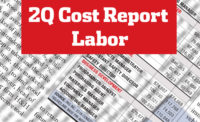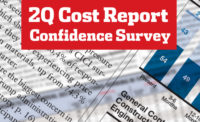2020 2Q Cost Report: Supreme Court Declines to Hear Repeal of Foreign Steel Tariffs

A steel bridge beam, fabricated by Industrial Steel Construction in Gary, Ind., arrives at the Mile Long Bridge jobsite near Hodgkins, Ill. Steel prices for contractors are still low, despite tariffs.
PHOTO BY JEFF YODERS FOR ENR
On June 22, the U.S. Supreme Court declined to hear a case brought by the American Institute for International Steel (AIIS), which represents importers of foreign-made steel which essentially ended the importer group’s effort to keep President Donald Trump from placing tariffs on their members’ steel under Section 232 of the Trade Expansion Act in 1962.
AIIS had argued the act was unconstitutional, but in declining without comment to hear the case, the high court signaled that only Congress can limit the executive branch’s power in trade. Both the U.S. Court of International Trade and the Federal Appeals Court for Washington, D.C., had previously upheld the tariffs.
“Every court that has looked at this challenge to Section 232 has found it to be constitutional,” said Brian Raff, a spokesman for the American Institute of Steel Construction, a Chicago-based trade organization that represents domestic fabricators and distributors. “AISC continues to work with the Department of Commerce and the administration to protect the American structural steel industry, through Section 232 and all other tools that are available.”
|
Related Link |
However, the Association of Equipment Manufacturers continues to oppose the tariffs its manufacturer members have to pay for the international steel if they cannot source domestic steel. “While the Supreme Court decided against hearing the case, we continue to urge the administration to use Section 232 on strictly national security grounds and in a transparent and factual manner,” said Kip Eideberg, AEM’s senior vice president of government and industry relations.
Domestic steel producers applauded the decision.
“This lawsuit by steel importers was a weak attempt to mask the fact that surging foreign imports have severely impacted the domestic steel industry and threaten our national and economic security,” said Thomas J. Gibson, president and CEO of the American Iron and Steel Institute, which represents domestic producers.
While the cost of using only domestic steel or paying tariffs for specialty products that need to be sourced abroad is also borne by contractors, Associated General Contractors of America found the impacts of tariffs on steel have not been as severe as its members originally anticipated. AGC said it was not closely tracking the case. The Arlington, Va.-based contractor trade group continues to focus on investment rather than tariffs.
“Broadly, our position remains that the best way to boost domestic production of key products like steel is to provide significant and consistent investments in infrastructure to ensure there is enough demand to sustain domestic steel production,” says AGC spokesman Brian Turmail. “Imposing tariffs is like fighting the symptom of our chronic underinvestment in infrastructure, as opposed to just boosting our investments in infrastructure.”
Through May, total and finished steel imports were 10.981 million and 7.3 million net tons, down 19.2% and 26.7%, respectively, over the same period in 2019, the U.S. Census Bureau says.
The decline in imports is not just because of tariffs. The pandemic has also hurt demand from end-users such as building owners and manufacturers. As AISI noted, both import volume and domestic steel prices have fallen, and analysts don’t expect a rebound until Q4 2020. AGC said without a manufacturing and construction rebound later in the year, prices will not recover by then, either.




